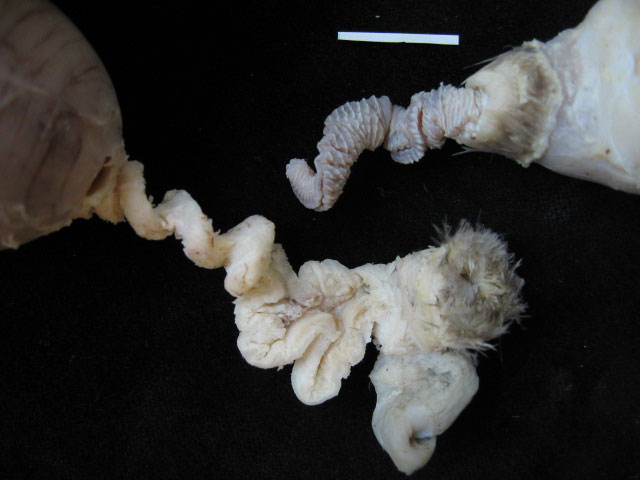Ducks Wage Genital Warfare

A sexual arms race waged with twisted genitals has been discovered in waterfowl.
The genitalia of the females of these species have at times apparently evolved to make it harder for males to successfully impregnate them, according to new findings that shed light on the eternal war of the sexes.
Most birds lack phalluses, organs like human penises. Waterfowl are among the just 3 percent of all living bird species that retain the grooved phallus found in their reptilian ancestors.
Male waterfowl are especially unusual in that their phalluses vary greatly among different species in length, ranging from a half-inch to more than 15 inches long. They also display a remarkable level of diversity how elaborate they are, ranging from smooth to covered with spines and grooves.
Scientists had speculated that male waterfowl evolved longer phalluses to give them a competitive edge over those not as well-endowed when it came to successfully fertilizing females.
After looking at the genitalia of a male duck, "I became immediately intrigued by what the female anatomy would look like to accommodate such a bizarre organ," said behavioral ecologist Patricia Brennan, who researches at both Yale University and the University of Sheffield in Britain.
Now Brennan and her colleagues unexpectedly find the vaginas of female waterfowl can be just as ornate as male genitalia, full of "dead ends" and other countermeasures that all seemed design to exclude the phallus, findings to be detailed online May 2 in the journal PLoS ONE.
Get the world’s most fascinating discoveries delivered straight to your inbox.
Like lock and key
In most birds, the vagina or oviduct is a simple tube. However, in some waterfowl, there are sacs in the sides of this tube, pockets that are just inside the opening of the oviduct. These sacs appear "to function as 'dead-ends,' or false passages," Brennan said. "If the phallus were to enter one of these sacs, it would not progress further into the oviduct where it would deposit sperm more effectively."
Waterfowl oviducts can also possess a series of tight, clock-wise spirals. "Interestingly, the male phallus is also a spiral, but it twists in the opposite, counterclockwise, direction," said Yale ornithologist Richard Prum, one of Brennan's co-authors on the research. "So, the twists in the oviduct appear designed to exclude the opposing twists of the male phallus," behaving like the opposite of a lock-and-key system.
The number of sacs and spirals in the reproductive tract of various female waterfowl seems to increase as the male phallus gets longer across the 14 different species of ducks and geese tracked by Brennan and her colleagues.
"I became very good at predicting what the genitalia of one sex would look like by looking at the other sex first," Brennan said.
This suggests the genitalia of males and females have evolved to surpass each other in a kind of escalating arms race over which sex gets to control reproduction.
"Despite the fact that most waterfowl form monogamous pairs, forced copulations by other males—the avian equivalent of rape—are common in many waterfowl," said Prum. The length of the phallus of a species is strongly linked with the frequency of forced copulations.
"In response to male attempts to force their paternity on females, female waterfowl may be able to assert their own behavioral and anatomical means of controlling who fathers their offspring," Brennan said.
This means that male waterfowl evolve more ornate phalluses to attempt to successfully overcome the physical defenses raised by ever more elaborate vaginas, and vice versa.
"Some large waterfowl that are highly monogamous, like geese and swans, have small phalluses, whereas other species that are quite small but more promiscuous have more elaborate genitalia," Brennan said. "A larger phallus is advantageous in situations where there is more promiscuity, while more monogamous species have a much reduced phallus."
Consent and cooperation
When females consent to advances from a chosen male, the researchers speculate female cooperation during copulation helps the phallus bypass female defenses.
"If the female is constantly struggling during unwanted copulations, this may prevent the phallus from being able to bypass the blind pouches," Brennan told LiveScience. When females cooperate during copulation, they "don't struggle," she added.
These findings "help dispel the notion that females are simply passive members of the battle between the sexes," said evolutionary biologist Robert Montgomerie at Queen's University at Kingston in Canada, who did not participate in this study. "This study, and many like it, serve to remind us that we should pay equal attention to both sexes when it comes to the process of making babies."
Ornithologist Kevin Johnson at the Illinois Natural History Survey in Champaign also noted these findings suggest "that other species that exhibit forced copulation behavior, although rare, should be examined" for similar adaptations to their anatomy.
Brennan plans to delve further into the development and evolution of genitalia in birds. "I am sure there are more surprises out there," she said.
- Animal Sex: No Stinking Rules
- Top 10 Monogamous Animals
- Top 10 Gay Animals



